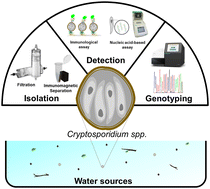Critical evaluation of current isolation, detection, and genotyping methods of Cryptosporidium species and future direction†
Abstract
Globally, Cryptosporidium continues to pose a significant health and economic burden despite significant efforts to develop effective on-site biosecurity and best management practices. According to the Global Burden of Disease Study (2016), this parasitic protozoan is responsible for more than 48 thousand deaths in children under the age of five and 7.2 million disability-adjusted life-years worldwide. Additionally, most Cryptosporidium species (e.g., Cryptosporidium hominis, Cryptosporidium parvum, etc.) are resistant to the majority of common disinfectants and can survive outside the body for extended periods. Consequently, it is crucial to establish a prompt and accurate diagnosis as well as the severity of the disease to prevent the spread of parasites and to enable effective management strategies. USEPA Method 1623 is currently used in centralized laboratories to perform routine diagnostic tests for this parasite. This process is laborious, expensive, and time-consuming. In the past ten years, a multitude of techniques based on conventional molecular biology techniques, such as polymerase chain reaction (PCR), nested-PCR, loop-mediated isothermal amplification (LAMP), recombinase polymerase amplification (RPA), and nucleic acid sequence-based amplification, have been utilized to analyze Cryptosporidium species. Similarly, several biosensing techniques have been developed in recent years, including electrochemical biosensors and the CRISPR-Cas system in lateral flow assays. This review discusses the most frequently employed techniques for isolating, quantifying, and genotyping Cryptosporidium species, and their implication on the diagnostic landscape. A subsequent evaluation of the most significant technical and biological challenges and limitations of these techniques is also undertaken.

- This article is part of the themed collections: REV articles from Environmental Science: Water Research & Technology and Environmental Science: Water Research & Technology Recent Review Articles


 Please wait while we load your content...
Please wait while we load your content...